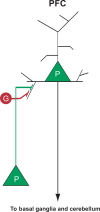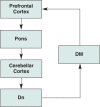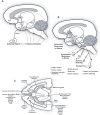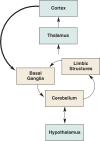Translational studies of alcoholism: bridging the gap
- PMID: 20041042
- PMCID: PMC2798743
Translational studies of alcoholism: bridging the gap
Abstract
Human studies are necessary to identify and classify the brain systems predisposing individuals to develop alcohol use disorders and those modified by alcohol, while animal models of alcoholism are essential for a mechanistic understanding of how chronic voluntary alcohol consumption becomes compulsive, how brain systems become damaged, and how damage resolves. Our current knowledge of the neuroscience of alcohol dependence has evolved from the interchange of information gathered from both human alcoholics and animal models of alcoholism. Together, studies in humans and animal models have provided support for the involvement of specific brain structures over the course of alcohol addiction, including the prefrontal cortex, basal ganglia, cerebellum, amygdala, hippocampus, and the hypothalamic-pituitary-adrenal axis.
Keywords: Alcohol dependence; alcohol and other drug effects and consequences; alcoholism; animal models; animal studies; brain; chronic alcohol exposure; environmental factors; genetic factors; human studies; neurobiology; translational studies.
Figures







Similar articles
-
Alcoholism: allostasis and beyond.Alcohol Clin Exp Res. 2003 Feb;27(2):232-43. doi: 10.1097/01.ALC.0000057122.36127.C2. Alcohol Clin Exp Res. 2003. PMID: 12605072 Review.
-
Chronic ethanol consumption: from neuroadaptation to neurodegeneration.Prog Neurobiol. 1998 Nov;56(4):385-431. doi: 10.1016/s0301-0082(98)00032-x. Prog Neurobiol. 1998. PMID: 9775400 Review.
-
[Neural network abnormalities caused by alcohol: approach for repair using neural stem cells].Nihon Shinkei Seishin Yakurigaku Zasshi. 2008 Apr;28(2):69-73. Nihon Shinkei Seishin Yakurigaku Zasshi. 2008. PMID: 18516985 Review. Japanese.
-
Decision making, risky behavior, and alcoholism.Handb Clin Neurol. 2014;125:227-36. doi: 10.1016/B978-0-444-62619-6.00014-8. Handb Clin Neurol. 2014. PMID: 25307578 Review.
-
[The neurobiology of alcoholism. Neuropathology and CT/NMR findings].Fortschr Neurol Psychiatr. 1995 Jun;63(6):238-47. doi: 10.1055/s-2007-996622. Fortschr Neurol Psychiatr. 1995. PMID: 7635386 Review. German.
Cited by
-
Alcohol: the lubricant to suicidality.Innov Clin Neurosci. 2013 Jan;10(1):20-9. Innov Clin Neurosci. 2013. PMID: 23440995 Free PMC article.
-
Do premorbid predictors of alcohol dependence also predict the failure to recover from alcoholism?J Stud Alcohol Drugs. 2010 Sep;71(5):685-94. doi: 10.15288/jsad.2010.71.685. J Stud Alcohol Drugs. 2010. PMID: 20731973 Free PMC article.
-
Function and dysfunction of prefrontal brain circuitry in alcoholic Korsakoff's syndrome.Neuropsychol Rev. 2012 Jun;22(2):154-69. doi: 10.1007/s11065-012-9198-x. Epub 2012 Apr 27. Neuropsychol Rev. 2012. PMID: 22538385 Free PMC article. Review.
-
Shared genetic factors influence amygdala volumes and risk for alcoholism.Neuropsychopharmacology. 2015 Jan;40(2):412-20. doi: 10.1038/npp.2014.187. Epub 2014 Jul 31. Neuropsychopharmacology. 2015. PMID: 25079289 Free PMC article.
-
The effect of alcohol withdrawal syndrome severity on sleep, brain and cognition.Brain Commun. 2020 Aug 14;2(2):fcaa123. doi: 10.1093/braincomms/fcaa123. eCollection 2020. Brain Commun. 2020. PMID: 33543128 Free PMC article.
References
-
- Abi-Dargham A, Krystal JH, Anjilvel S, et al. Alterations of benzodiazepine receptors in type II alcoholic subjects measured with SPECT and [123I]iomazenil. American Journal of Psychiatry. 1998;155:1550–1555. - PubMed
-
- Adalsteinsson E, Sullivan EV, Pfefferbaum A. Biochemical, functional and microstructural magnetic resonance imaging (MRI) In: Liu Y, Lovinger DM, editors. Methods in Alcohol-Related Neuroscience Research. Boca Raton, FL: CRC Press; 2002. pp. 345–372.
-
- Adams KM, Gilman S, Koeppe R, et al. Correlation of neuropsychological function with cerebral metabolic rate in subdivisions of the frontal lobes of older alcoholic patients measured with [18F]fluorodeoxyglucose and positron emission tomography. Neuropsychology. 1995;9:275–280.
-
- Adinoff B, Martin PR, Bone GH, et al. Hypothalamic-pituitary-adrenal axis functioning and cerebrospinal fluid corticotropin releasing hormone and corticotropin levels in alcoholics after recent and long-term abstinence. Archives of General Psychiatry. 1990;47:325–330. - PubMed
-
- Afifi AK, Bergman RA. Functional Neuroanatomy: Text and Atlas. New York: McGraw-Hill; 1998.
Publication types
MeSH terms
Substances
Grants and funding
LinkOut - more resources
Full Text Sources
Medical
Miscellaneous
